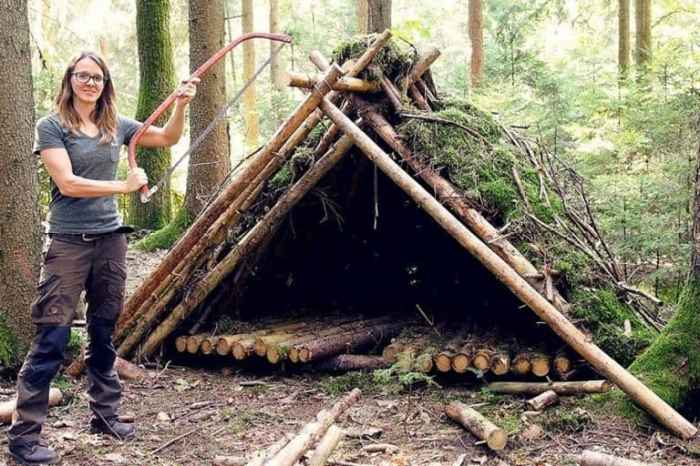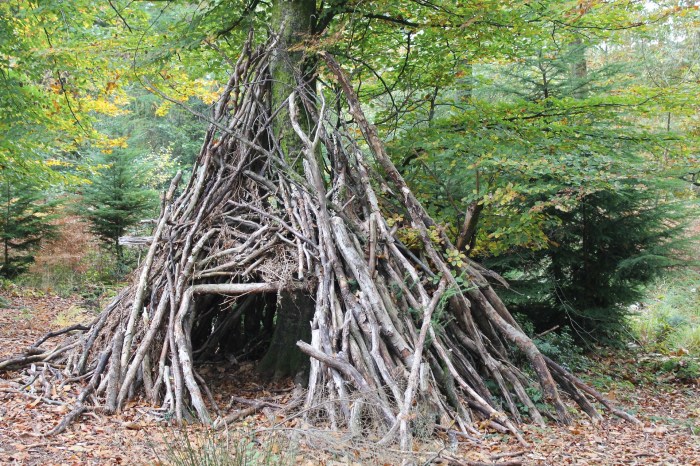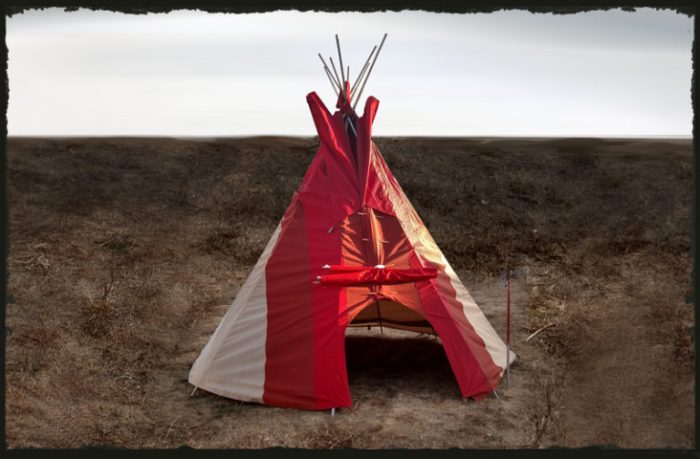A shelter made of buffalo skins is a testament to the ingenuity and adaptability of nomadic and indigenous communities. These structures, steeped in cultural significance, have played a vital role in shaping the lives and traditions of people across vast landscapes.
Buffalo skin shelters were not merely dwellings but symbols of resilience, providing protection from the elements, fostering a sense of community, and embodying the cultural heritage of their inhabitants.
History and Cultural Significance

Buffalo skin shelters, also known as tipis or teepees, have a rich history and cultural significance among nomadic and indigenous communities across the Great Plains of North America.
The origins of buffalo skin shelters can be traced back to the nomadic lifestyle of Native American tribes, who relied on these portable and adaptable structures for shelter during their seasonal migrations. The use of buffalo skins as a building material was particularly advantageous due to their durability, insulation, and resistance to the harsh weather conditions of the Great Plains.
Role in Nomadic Communities
For nomadic communities, buffalo skin shelters served as versatile and practical dwellings. Their conical shape and central smoke hole allowed for efficient ventilation and heat distribution, making them comfortable and habitable in various weather conditions. The portability of tipis also enabled nomadic tribes to quickly and easily relocate their camps as they followed bison herds or sought new hunting grounds.
Cultural Symbolism
Beyond their practical function, buffalo skin shelters held significant cultural and spiritual value for Native American communities. The tipis were often decorated with intricate designs and symbols that represented tribal identity, clan affiliations, and personal achievements. The central smoke hole was also considered a sacred space, believed to connect the dwelling to the spirit world.
Construction and Materials

Traditional buffalo skin shelters were meticulously constructed using time-honored techniques and materials.
The process began with the selection of high-quality buffalo skins, typically sourced from mature animals. The skins were then carefully prepared through a series of steps involving scraping, stretching, and drying.
Preparation of Buffalo Skins
- The skins were scraped to remove any remaining flesh or fat.
- They were then stretched and secured to wooden frames to dry in the sun and wind.
- Once dry, the skins were treated with natural preservatives, such as animal fat or smoke, to enhance their durability and resistance to weather conditions.
Structural Features and Design
Buffalo skin shelters exhibit unique structural features that ensure their stability and functionality in various environments. Their design reflects the architectural ingenuity of Native American tribes.
These shelters typically have a dome-shaped or conical form, providing ample headroom and space for occupants. The shape allows for efficient shedding of rain and snow, preventing water accumulation and ensuring a dry interior.
Ventilation System
Buffalo skin shelters incorporate a well-thought-out ventilation system. Smoke holes are strategically placed at the top of the shelter, allowing smoke from the central fire to escape while maintaining warmth inside. Adjustable flaps or openings at the base of the shelter allow for additional ventilation and temperature regulation, ensuring a comfortable living environment.
Environmental Adaptations
Buffalo skin shelters were designed to withstand a variety of climates and environments. Their adaptability made them suitable for use by nomadic tribes who traveled across vast territories.
A shelter made of buffalo skins is a traditional dwelling for nomadic people. The skins are stretched over a frame of wood or bone, providing a sturdy and weatherproof shelter. If you have a lot of land, you could build a large shelter.
A farmer has 2400 ft of fencing and could use it to enclose a large area for his livestock. He could then use the buffalo skins to build a shelter for himself and his family.
In cold climates, buffalo skins provided excellent insulation, keeping inhabitants warm during harsh winters. The thick, dense fur trapped air and created a barrier against the cold. Additionally, the natural oils in the skin repelled moisture, preventing water from penetrating and causing discomfort.
Advantages of Using Buffalo Skins in Cold Climates
- Excellent insulation
- Water-repellent
- Durable and long-lasting
In warm climates, buffalo skin shelters provided shade and ventilation. The thick fur blocked out direct sunlight, keeping the interior cool and comfortable. The open structure of the shelter allowed for air circulation, preventing the buildup of heat and humidity.
Advantages of Using Buffalo Skins in Warm Climates
- Shade from direct sunlight
- Ventilation for air circulation
- Lightweight and easy to transport
Cultural and Social Implications: A Shelter Made Of Buffalo Skins

Living in a buffalo skin shelter had profound cultural and social implications for the people who inhabited them. These shelters influenced daily life, community interactions, and cultural practices in significant ways.
Daily Life
The structure and layout of the shelter dictated the organization of daily life. The central hearth provided warmth and light, and served as a gathering place for cooking, eating, and socializing. The sleeping area was typically located around the perimeter of the shelter, with each family or individual having their own designated space.
Community Interactions
Buffalo skin shelters fostered a sense of community among the inhabitants. The close proximity of the shelters encouraged frequent interactions and the sharing of resources. The communal space around the hearth served as a place for storytelling, singing, and other forms of social bonding.
Cultural Practices, A shelter made of buffalo skins
The shelter also played a role in cultural practices and rituals. The buffalo skin itself was considered a sacred material, and its use in shelter construction carried spiritual significance. The shelter was often adorned with symbolic designs and objects, which reflected the cultural beliefs and traditions of the inhabitants.
Modern Adaptations and Uses
Buffalo skin shelters have found new life in contemporary settings, showcasing their adaptability and enduring relevance. Traditional designs have been modified and repurposed to meet modern needs, while preserving the cultural significance and practical advantages of these structures.
Residential Use
- Buffalo skin tipis continue to be used as dwellings in some Native American communities, offering a connection to traditional heritage while providing shelter.
- Modern architects have incorporated buffalo skin into contemporary home designs, creating unique and sustainable structures that blend traditional and modern aesthetics.
Commercial and Recreational Use
- Buffalo skin shelters are popular at cultural events and festivals, providing a glimpse into the past and a unique gathering space.
- Hunting lodges and outdoor retreats often utilize buffalo skin shelters for their warmth, durability, and cultural ambiance.
li>Glamping (glamorous camping) enthusiasts have embraced buffalo skin tipis as a luxurious and authentic way to experience nature.
Educational and Cultural Use
- Museums and cultural centers display buffalo skin shelters as educational exhibits, showcasing their historical significance and construction techniques.
- Living history programs and reenactments use buffalo skin tipis to recreate historical events and provide immersive learning experiences.
Cultural Preservation and Heritage

Preserving buffalo skin shelters as cultural heritage is crucial for several reasons. They embody the ingenuity and resilience of indigenous communities and serve as a tangible connection to their past. These structures represent the cultural identity and traditions of these communities and provide valuable insights into their history and lifestyle.
Efforts are being made to document and safeguard these traditional structures. Indigenous communities, in collaboration with historians, anthropologists, and conservationists, are working to record the construction techniques, materials, and cultural significance of buffalo skin shelters. Museums and cultural institutions are also playing a role in preserving these structures by acquiring and displaying them in exhibitions.
Education and Awareness
- Educational programs and workshops are conducted to teach younger generations about the cultural importance of buffalo skin shelters and the skills involved in their construction.
- Public outreach initiatives aim to raise awareness about the significance of these structures and encourage their preservation.
Tourism and Economic Impact
- Preserving buffalo skin shelters can contribute to cultural tourism, attracting visitors interested in experiencing and learning about indigenous heritage.
- This can provide economic benefits to local communities by creating employment opportunities in tourism and related industries.
FAQ Resource
What is the significance of buffalo skin shelters in nomadic communities?
Buffalo skin shelters were essential for nomadic communities, providing portable and durable dwellings that could withstand the rigors of travel and the harsh conditions of the open plains.
How were buffalo skin shelters constructed?
Traditional buffalo skin shelters were constructed using a framework of wooden poles covered with cured buffalo skins. The skins were carefully prepared and sewn together to create a waterproof and windproof covering.
What are the advantages of using buffalo skins for shelter?
Buffalo skins are highly durable, insulating, and water-resistant, making them an ideal material for shelters in various climates. They provide excellent protection from the elements and can withstand extreme temperatures.